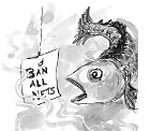Something about Initiative 696, the “Ban All Nets” measure on November’s ballot, must cloud people’s minds. Like mine: Two weeks ago, I referred to it as “No Nets” 676. I can’t really blame the cloud cover for this particular bungle; juggling column items to fit the space, I plugged this one in without noticing it was still in raw form. In other words, this column is a product of mixing, matching, switching, and patching. We’ll change its name to “Sausage”: If you knew how it was made, you wouldn’t want to read it. And if you would vote to “Ban All Nets” but not for “No Nets,” don’t be put off.
Them what’s got shall get
On the other hand, you shouldn’t expect I-696 to “ban all nets.” As its own text notes, it would only affect non-Native commercial fishers and “not extend to those tribal fisheries conducted under a valid treaty right.” If it didn’t say that, the courts would; 15 years ago they threw out an initiative, promoted by white fishers, that would overturn treaty fishing rights. Nevertheless, the proponents seem to have their sights on tribal fishing too. Aaron Johnson, I-696’s campaign manager, says that the ban on nearly all types of nets would apply to tribes as well because their treaties guarantee them the right to fish “in common” with non-Indians, and that means they should only use the same gear. This is a fanciful view—or, as another I-696 booster, ex-state fisheries official Jim Tuggle, calls it, “just crazy.” Treaty rights have never been interpreted thus, and tribes have long used gear forbidden to others.
Still, Johnson argues, “It just seems intuitively true” that the 696 gear limit should apply to them. “We haven’t had time to check with lawyers. We have a campaign to run.” You get an inkling of how well they’ve thought through this measure that would wipe out this state’s commercial fishery at a stroke.
Mixed effects
With the commercial fishery gone, the tribes could claim the fish that go uncaught under the doctrine of “foregone opportunity.” Sam Wright, another apostate ex- fisheries official (see “Scraping bottom,” SW 8/19), forecasts just this outcome in a review of I-696 he recently wrote for the sports/conservation group Washington Trout. Wright predicts that in Willapa Bay, where there’s no tribal fishery, and the Columbia River, where Indians and non-Indians fish different areas, I-696 would reduce the salmon take. But on the Olympic Peninsula, where there’s no non-Native commercial fishery, it would make no difference. And in Puget Sound and Grays Harbor, it would merely “shift the [salmon] harvest” to tribal and sports fishers. Wright argues that would give state managers more “incentive” to reduce the total harvest.
One for me, none for you
Wright himself tries to avoid these “allocation battles” over who gets what, rather than what gets protected. He notes that “taking sides with one user group [sportsmen] over another” was what sank his old boss, ex-state fisheries director Bern Shanks (now an I-696 partisan). “The problem is both commercial and sports fishing,” adds Wright. “Both have been allowed to fish where they shouldn’t have.” Under I-696, only one would.
Strange boatfellows
Nevertheless, Wright’s mixed review helped persuade Washington Trout to come out for 696. That was a coup; unlike the Puget Sound Anglers, the group behind 696 and previous anti-commercial fishing efforts, Washington Trout director Kurt Beardslee has cred with greens. Other outdoor recreation groups have declined to endorse, and other environmental groups have come out solidly against 696. That hasn’t stopped proponents from claiming green support. They trumpeted an endorsement from the Earth Island Institute far and wide. Shanks also claimed, in a News Tribune op-ed (10/10), that “the Audubon Society” had endorsed 696.
In fact, just a handful of local Audubon chapters endorse 696; the largest, in Seattle, opposes it. And the Earth Island Institute declared three weeks ago that because “I-696 is overly broad,” it would stay neutral. Mark Berman, its point man on fisheries issues, concedes the institute initially endorsed 696 after being “led to believe it would ban only large-scale drift nets and trawlers,” as have limited net bans in California and other states. But once it learned 696 would ban nearly all commercial fishing, it feared its endorsement might offend tuna seiners who’ve cooperated in preventing dolphin kills. I-696 manager Johnson counters, “I faxed [Berman] a copy of the initiative before he signed the endorsement letter.”
“He stole our Web site”
That’s just one of many sideshows to the I-696 fight, which seems even more steeped in pranks, low blows, and bad blood than I-695. The campaign spokespeople said they declined to sit down with their opponents because commercial fishing lobbyist Ed Owens had gone berserk at a Thurston County Republican forum. One attendee reports, in a letter to the Weekly, that Owens “shouted at everyone at the event,” claimed hosts had packed it with sports fishermen, and “put his face about an inch” from I-696 author Tom Nelson. Owens, who seems to be suffering campaign fatigue, insists that the shouting was mutual, that the other side has been packing meetings and booing down critics, and that the brouhaha began when he called Nelson a “thief” for preemptively registering the Web domain (www.NoOn696.org) opponents had said they’d use. “What’s wrong with that?” asks 696’s Johnson. “If they owned [the domain] we wouldn’t have been able to buy it.”








